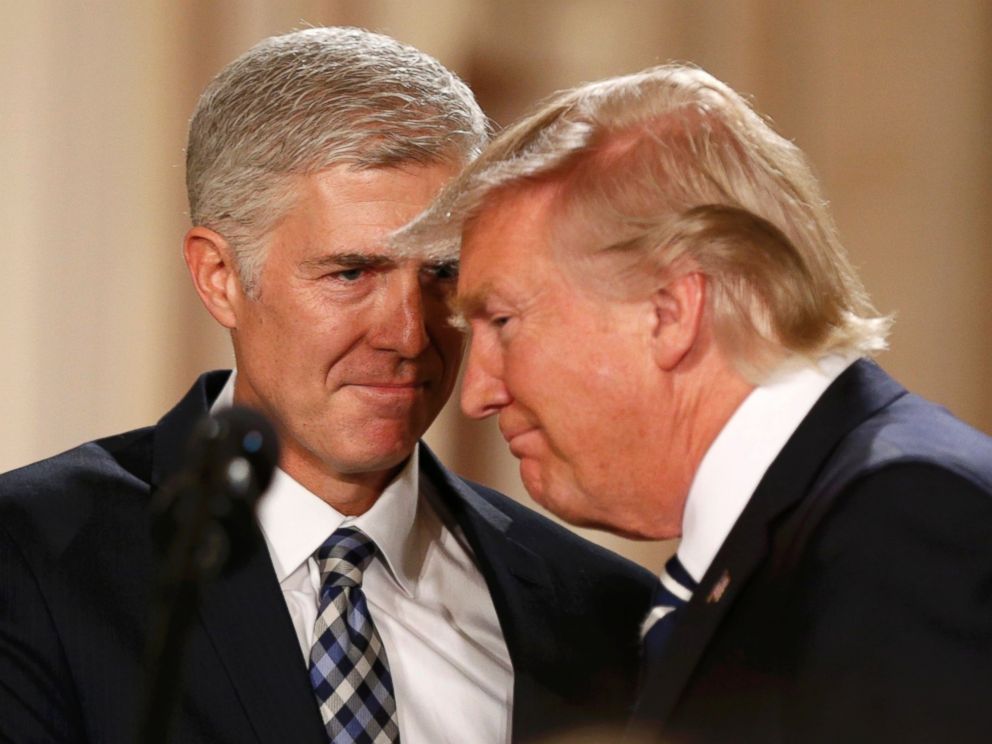By Jonathon Van Maren
Abortion activists are afraid that Donald Trump’s presidency could end legal abortion in America.
That’s a sentence I never thought I’d write, and to be honest, I think that abortion activists are perhaps overstating the case. For starters, they need to overstate their case—it’s true that pro-lifers are pressing their advantage as never before, especially after eight years of the most pro-abortion administration in American history and what appeared at the time to be the imminent threat of abortion enthusiast Hillary Clinton. Abortion activists desperately need their base to be motivated, active, and pushing back with everything they’ve got, especially with new pro-life Supreme Court Justice Neil Gorsuch, a plethora of pro-life appointments in the Trump Administration, and the very real possibility that Planned Parenthood may get defunded in the near future.
Secondly, the state-level legislation abortion activists are pointing to as evidence that the pro-life movement is on the march is nothing new—pro-lifers have been experiencing record levels of success in state legislatures, with well over three hundred pro-life laws passing in the last decade, all while Barack Obama enthusiastically palled around with Planned Parenthood whenever the opportunity arose. But that being said, the writers over at Refinery29 penned a column titled “This Is How Abortion Ends In America” warning that the “enthusiasm might be too little, too late.” They then describe the “dominoes” that are lined up and ready to topple:
- Roe V. WadeWas Never A True Win For Women
Before Roe v. Wade was decided on January 21, 1973, abortion was criminalized in 44 states; nearly every state had to re-work its laws after the decision. Roe made the termination of an unwanted pregnancy during the first trimester legal nationwide. (Regulation of second- and third-trimester abortions was and still is left to the states.) Feminists hailed the decision a major victory, yet Roe v. Wade was never a “feminist” law — not really. In fact, the very ruling that made abortion legal in the U.S. is exactly what has made these rights so precarious.
To understand how that could possibly be, just look at what Roe actually says: that people have a right to privacy under the Constitution’s 1st, 4th, 9th, and 14th amendments, and abortion is ultimately an issue of that privacy. That’s a foggy way to guarantee a woman’s right to make choices about her body, and so it doesn’t really do that. Also: None of those amendments actually mentions the word “privacy.”
“If you sit down and read Roe v. Wade, it’s surprising that there’s really almost no feminist language in the opinion,” says Linda Greenhouse, a former Supreme Court correspondent for The New York Times and co-author of Before Roe V. Wade. “It’s not written from the point of view of women. The idea was really to enable doctors to act in what they regarded as the best interest of their patients, without risking being prosecuted or going to jail.”
In short, Roe was a decision deeply rooted in the times. In the 20,000 word decision, there is no mention of women’s rights, period, though there are several mentions of the doctor’s rights to attend to his patient however he sees fit. This is important because Supreme Court rulings are not law in the same way a law that’s passed by Congress is; they’re simply interpretations of the Constitution, made by the people who happen to be sitting on the bench at the time.
This is why Roe was weak from the start. First, because it became law via the Supreme Court’s interpretation; and second because that interpretation was based on an implied right of privacy, not something that is expressly written in the Constitution. Even Ruth Bader Ginsburg, progressive darling of the bench, has called Roe “bad law,” arguing that it would have been stronger had the right to an abortion been based on the 14th amendment’s equal protection clause. In short, Roe was always a little flimsy, and some — like Ginsburg — have argued that a more gradual change in state legislatures and the courts would’ve been a safer way to secure our rights; one with less backlash against them. Because the backlash has been fierce.
Secondly, the writers point out that the pro-life movement has successfully infiltrated the Republican Party:
- The “Pro-Life” Movement Takes Over the Republican Party
…In 1980 Reagan would win the presidency, largely due to his support of what Time Magazine called in 1981 “the most powerful single-issue force in American politics” — the burgeoning “right to life” movement. He was the first presidential candidate to put abortion on his campaign platform, and he promised to appoint Supreme Court justices who’d take down Roe if elected (sound familiar?). A socially conservative Republican party was born.
Again, while they have a point, the writers have overstated their case somewhat. It was Phyllis Schlafly and hardworking pro-life activists who brawled from convention to convention to insert pro-life planks in the Republican Party, often against the will of the establishment politicians. Even now, Republicans are notorious for taking the pro-life movement for granted, simply assuming that pro-life voters have nowhere else to go and bumping the movement’s concerns far down on the legislative agenda. But still, Trump’s judicial appointments and pro-life administration official picks have thus far been very encouraging.
On point three, however, the panicked abortionists are bang-on: Pro-lifers have been magnificent in passing legislation restricting abortion on the state-level:
- Regulate! Regulate! Regulate!
The aforementioned Catholic-driven Americans United for Life organization ominously calls itself the “the legal architect of the pro-life movement.” Originally founded in 1971, it spent the first half of that decade raising funds and forming a legal strategy with a tight focus on state legislatures and the courts, rather than changing federal law. According to AUL’s website, that strategy “served to bolster pro-life policies, legal precedents, public attitudes, and coalitions that pro-life leaders can build upon in order to enact broader pro-life laws and prepare for the day when Roe’s eventual reversal returns abortion jurisdiction to the states.”
This legislation often comes from the waves of conservative legislators who are far more pro-life than the infamous “RINOS”—“Republicans In Name Only”:
- 2010: The beginning Of The End
You’ve heard of the Tea Party, right? In 2010, riding the wave of disgust over the passage of Obamacare, a new, more extreme group of Republicans took over Congress. More importantly, as far as abortion is concerned, they took over state capitals. According to polling research firm Rasmussen, Republicans won control of 25 state legislatures in 2010, up from 14 the year before, while Democrats were left with 16. Republicans added six governors to their ranks, as well…these were radicals. “Prior to 2010, we had more moderate conservatives in power at the state level nationwide. These issues just didn’t come up on the state-level in the same way as we’ve seen since then,” says Elizabeth Nash, the senior state issues manager for the Guttmacher Institute, a nonprofit that researches abortion laws and access. “There was a sea change that year, and it hasn’t shifted back yet.”
The result: A whopping 338 abortion restrictions have been passed over the past six years, according to the Guttmacher Institute. This means that a full 30% of abortion restrictions enacted in the four-plus decades since Roe have all come about in just a handful of years. The laws, which again were often written by the AUL and other players in the anti-choice lobby, also got more severe: They have covered everything from defunding Planned Parenthood to putting regulations on abortion clinics that were so formidable (and unnecessary) they forced many to shut down. This included things like requiring doctors who perform abortions to have admitting privileges at hospitals, and requiring clinics to meet the standards of surgical centers that do far more complex procedures.
The geographic area in which anti-choice politicians held sway also ballooned. “From 1985 to 2010 there were 189 abortion laws passed. But in total, this was happening in about 13 states,” explains Willie Parker, MD, board chair of Physicians for Reproductive Health. “Now it has grown to about 27 states.” This means that although abortion remains legal, for a growing number of women across the country, it’s become impossible to get.
In June 2016, the Supreme Court overturned the Texas law that required doctors get admitting privileges, that clinics meet the standards of surgical centers, that banned abortion at 20 weeks, and that required women who wanted to take the abortion pill to do so supervised by a physician. That was Whole Woman’s Health v. Hellerstedt, and it was decided with one fewer justice than usual. While this was a win for the forces of choice, it was too late: More than half of Texas’ 41 abortion clinics had already closed.
The result of this wave has been the lowest abortion rate in the United States in decades, which one would think could be considered a good thing. This impact, of course, is still restricted to states where pro-life legislators have been successful. There are still some places where the abortion rate is horrifyingly high—in New York City, for example, nearly 70% of pregnancies end in abortion. But with the return of politicians with pro-life values to the halls of power, things could improve even further:
- Donald Trump Wins, & Republicans Sweep
And this brings us to the 2016 election, which brought Donald Trump into the White House with Mike Pence his vice. Both chambers of Congress are now controlled by Republicans, clamoring to defund Planned Parenthood, and wipe out women’s healthcare along with it.
It’s hard to envision abortion rights surviving this administration. In January, Pence became the highest ranking federal official ever to attend the March for Life, the annual march on Washington that started as a protest on the ruling’s very first anniversary, 1974. “Life is winning!” he declared before a roaring crowd. Kellyanne Conway, the event’s keynote speaker, offered this gem: “This is a new day, a new dawn for life.” Indeed.
Abortion activists are terrified that the one thing pro-lifers are praying for will happen: that Trump might get to appoint a second Supreme Court justice:
- Next up: Could SCOTUS turn to the dark side?
As we said: Cases involving abortion are often the closest calls, decided by a one-judge difference between yes or no. While the current court is split the same way it was when it decided in favor of access a year ago, that could change soon.
We don’t mean to be crass, but three of the five justices who’ve historically protected abortion access share an average age of 80: Ruth Bader Ginsburg is 84; Anthony Kennedy is 80; and Stephen Breyer is 78. To put that into perspective: Since 2005, four justices have left the bench, either by dying or retiring, at the average age of 81.5. Just one needs to go before 2020 — that’s it.
Of course, this doesn’t necessarily mean that Trump’s second appointment would be an anti-Roe pro-lifer, although the signs are certainly positive. Roe v. Wade was decided and upheld by Republican-appointed justices for decades, Anthony Kennedy included. Neil Gorsuch’s appointment, at least, is a good indication that Trump is willing to follow through on his promise to appoint originalist justices to the Court. If this happens and Roe is overturned, the writers say there are only two possible scenarios, both of which effectively end abortion in America:
The first scenario: President Trump seems to believe in a states’ rights approach to banning abortion. The Center For Reproductive Rights estimates that women in 33 states are at risk of losing abortion rights without Roe. In fact, there are 15 states with old abortion bans on the books ready to come back into effect as soon as Roe is lifted. While a few states may continue to offer legal abortion (New York Governor Cuomo has proposed writing abortion rights into the New York Constitution), it will become cost prohibitive for many people to travel to and pay for the procedure — and where would they even go?
Other than leaving the country, they would have to head to places like New York, California, or Washington, which have historically been more friendly to these rights than other states. But could just a handful of states actually handle the entire population of women needing care? After Texas’ severe regulation bill passed (and before it was struck down last summer), wait times at the clinics that remained open increased to as long as 21 days just to get an appointment, says Daniel Grossman, MD, an Ob/Gyn and director of the Advancing New Standards in Reproductive Health (ANSIRH) research group at the University of California, San Francisco. That’s a three-week wait. Now, just imagine having to travel from out of state only to end up on a wait list that could be so long you miss your window.
Then there’s the matter of paying for the procedure itself. The government already does not pay for abortion under public insurance programs, like Medicaid, except in the cases of life endangerment or rape — the Hyde Amendment established that when it was passed in 1976. Private insurance pretty much doesn’t cover it, either: Currently, 10 different states restrict abortion coverage in insurance plans. In 25 states, plans sold on Obamacare exchanges are restricted in terms of abortion coverage; public employee plans in 21 states are barred from covering abortion. And in the latest iteration of the GOP’s healthcare bill, private insurance plans would lose out on tax breaks if they offered abortion coverage — making the plans that do offer it more expensive and harder to find. The point is, women already pay out of pocket for these procedures for the most part, which can cost up to $3,000.
Then, if abortion is illegal in your state, you have to add the cost of traveling to that, which could encompass gas for your car or a bus ticket, or airfare plus lodging if you have to go far. “As the distance to the nearest facility increases, at some point that distance just becomes too far, especially for a low-income woman,” Dr. Grossman, of UCSF, says. “She will then be forced to carry an unwanted pregnancy to term.”
All of this is to say: Once Roe is gone, and without any new legislation being written, abortion would become an exclusive benefit of the 1%.
The second scenario: Let’s say the Supreme Court Justice writing the opinion overturning Roe decides to take the decision to the next level and extend the Constitution’s protections for all people to a fertilized egg or fetus. Suddenly, we’ve got “personhood” on the books.
Thinking of an unborn fetus as a person has always been the goal of the “pro-life” movement. To them, a fetus’ right to potential life trumps anyone’s right to make private choices.
In other words? That’s certainly a lot of “ifs,” but it is certainly imaginable that one of these two scenarios could play out over the next few years. Abortion activists are going to fight like they’ve never fought before, because the threat to their bloody industry is existential. Pro-lifers are going to fight like they’ve never fought before because this could very well be the last clear shot they have of taking the Supreme Court, toppling Roe, and brawling for the lives of pre-born children state by state. For the pro-life movement, it is time to pray and work like never more.
__________________________________
For anyone interested, my book on The Culture War, which analyzes the journey our culture has taken from the way it was to the way it is and examines the Sexual Revolution, hook-up culture, the rise of the porn plague, abortion, commodity culture, euthanasia, and the gay rights movement, is available for sale here.









Tha abortion stops ubrabtly the beating of a an unborn child’s heart and deprives it from years of precious life’s experiences , joys and blessings.
The convenience of a Mather should not take precedence over the life of the unborn child.
If you have the opportunity to extend a life or to terminate a life choose to extend it !!!
It requires denial of self to extend the life of the unborn child, but the rewards are unprecedented .
Hate to put a damper on this, but the Supreme Court case that overruled Roe is Casey v. Planned Parenthood, and it is full of meaningless rhetoric, like defining oneself in relation to the universe. That is Kennedy, and it sounds fairly feminist to me.